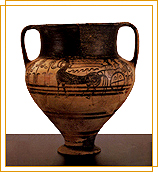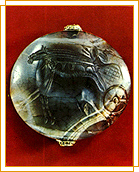Mycenean Greece
In Mycenean Greece (1600-1100 BC), as in Minoan Crete, athletic
contests formed an important part of the religious ceremonies and
fertility rites.  The Myceneans differed from the Minoans in their
love for war and their natural inclination in hunting- occupation
that was considered as an athletic event. That explains why they
added running and chariot racing to somersault, bull-leaping and
boxing, events which they had borrowed from the Cretans. The Myceneans differed from the Minoans in their
love for war and their natural inclination in hunting- occupation
that was considered as an athletic event. That explains why they
added running and chariot racing to somersault, bull-leaping and
boxing, events which they had borrowed from the Cretans.
Somersault did not become particularly popular in Mycenean Greece and bull leaping -as one can see in representations appearing on seals and finger-rings, wall-paintings as well as on the clay larnax from Tanagra -was considered as a funerary athletic contest. Boxing and wrestling, on the other hand, proved to be the most popular contests for the Myceneans who passed them over in Cyprus in the late Mycenean Period. A Mycenean vase from Cyprus shows boxing scenes together with the earliest representation of a running contest, during which the runners are naked bearing ornaments on their heads.
The chariot was introduced to the Myceneans from the East and was originally used as a means of communication among the members of the upper social classes. It was later used in the processions of various rites,  in hunting, in transporting the warriors to the battlefield and finally in chariot races. It is very likely that during the Mycenean period chariot races were performed in the context of religious and mainly funerary rites. For example, the earliest representation of a chariot to be found in the Mycenean Art is the one existing on the funerary headstones of the funerary circle A in Mycenae, dating from the 16th century BC. Moreover, the larnax of Tanagra, an important funerary monument of the 13th century BC, bears a representation of a chariot race besides a representation of wrestling and bull-leaping. The belief that the Myceneans have established the contests, known as "funerary contests", in honor of a celebrated dead, was mainly based on the Homeric Iliad, where the contests appear as an important part of the funerary events. This is suggested in the description of the athletic contests that were organized in memory of the dead hero Patroclus. in hunting, in transporting the warriors to the battlefield and finally in chariot races. It is very likely that during the Mycenean period chariot races were performed in the context of religious and mainly funerary rites. For example, the earliest representation of a chariot to be found in the Mycenean Art is the one existing on the funerary headstones of the funerary circle A in Mycenae, dating from the 16th century BC. Moreover, the larnax of Tanagra, an important funerary monument of the 13th century BC, bears a representation of a chariot race besides a representation of wrestling and bull-leaping. The belief that the Myceneans have established the contests, known as "funerary contests", in honor of a celebrated dead, was mainly based on the Homeric Iliad, where the contests appear as an important part of the funerary events. This is suggested in the description of the athletic contests that were organized in memory of the dead hero Patroclus. |
